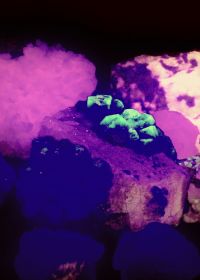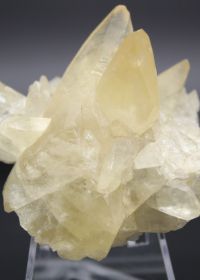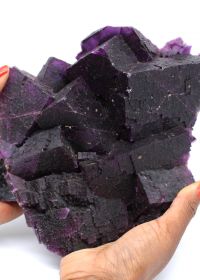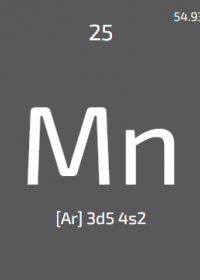Geology and Mineralogy Gallery of the Jardin des Plantes in Paris
Fluorescent Minerals: When Stones Glow in the Dark
Mineral & Gem 2025: a major international mineralogical exhibition
The History of the Gold Rush in the United States
Discover vanadinite
The Mineralogy of Spain: A Hidden Treasure
Fluorescent Minerals: When Stones Glow in the Dark
When science makes nature shine
Have you ever seen a stone magically glow under ultraviolet light? This impressive phenomenon, called mineral fluorescence, is as intriguing as it is as amazing. It's not a magic trick, but rather a natural property of certain minerals, crystals, or raw stones: when exposed to UV light, they emit a visible glow—sometimes green, blue, red, or even multicolored.
In the world of fossils, decorative stones, natural stone jewelry, and objects like lamps, spheres, and hearts, fluorescence adds a magical dimension. Whether we're talking about geodes, rock slices, crystals on matrix, or polished stone bracelets, this natural characteristic gives fluorescent pieces a unique aesthetic and emotional value.
This article invites you to discover this fascinating phenomenon, its scientific origins, the minerals involved, its interest in collecting and decorating, and even some advice if you want to start a collection of fluorescent stones.
What is mineral fluorescence?
Albarubescens, CC BY 4.0 , via Wikimedia Commons


Mineral fluorescence is a physical phenomenon that occurs when certain minerals are exposed to ultraviolet (UV) rays. Under the influence of this light, invisible to the naked eye, minerals absorb energy, temporarily excite electrons, and then release this energy in the form of visible light. It is this emitted light that gives the stones their spectacular glow in the dark.
But be careful: not all stones are fluorescent. Only certain minerals containing activating elements (such as manganese, tungsten, or certain rare earths) react to UV. These elements, called activators or chromophores, are responsible for the color of the fluorescence. The examples you cite are indeed common activators:
- manganese (Mn): Can produce red, orange, yellow or green fluorescence.
- tungsten (W): Is often associated with blue-white fluorescence.
- Rare earths (such as europium, terbium, dysprosium): Can generate a wide range of vivid colors, including red, green, and yellow.
However, the presence of an activator is not the only condition. Other factors influence fluorescence, such as:
- The crystalline structure of the mineral: It must allow the incorporation of the activator and the transmission of energy.
- The presence of inhibitors (or "quenchers"): Certain elements can block or reduce fluorescence. iron (Fe) is a common inhibitor.
- The type and wavelength of UV rays: Some minerals react better to short waves (UV-C and UV-B), while others are more sensitive to long waves (UV-A).
We often distinguish between two types of UV light:
- Longwave UV (365 nm): Used in many consumer UV lamps.
- Shortwave UV (254 nm): more powerful and often used in museums and professional collections. Some stones only react to this type of wave.
Fluorescence can be temporary (it stops as soon as the UV light is turned off), unlike phosphorescence, which continues to glow for a short time after exposure. This phenomenon does not change the structure of the mineral in any way: it is a purely luminous effect, without chemical transformation.
For natural stone lovers, this means that items like pendants, rings, earrings, or bracelets made from fluorescent minerals can reveal a hidden and surprising facet under UV light. A fluorite necklace or calcite geode takes on a whole new dimension when exposed to UV light.
Why are some minerals fluorescent?
Fluorite verte de Madgascar


Not all minerals exhibit fluorescence, and this phenomenon depends on several chemical and structural factors. For a mineral to glow under UV light, it requires a specific combination of chemical composition, crystal structure, and sometimes activating impurities.
1. The role of chemical elements
Fluorescence is often caused by trace elements called "activators." These can include:
- manganese (Mn)
- Uranium
- Tungsten
- Rare earths (such as europium or dysprosium)
These elements replace other atoms in the crystal's structure and alter its response to UV light. For example, fluorite, a stone well-known for its fluorescence, can glow blue, green, purple, or yellow depending on its impurities.
2. The crystal structure
Certain mineral structures are more likely to exhibit fluorescent activity. The way atoms are organized in the stone influences their ability to absorb and re-emit light.
3. Influence of the type of UV light
As mentioned earlier, some minerals only react to shortwave UV, while others glow under longwave UV. Therefore, it is important to use the right type of UV lamp to reveal a mineral's full fluorescent beauty.
4. Highly variable reactions
Even two specimens of the same mineral can react differently depending on their geographic origin or exact composition. This is what makes collecting fluorescent rough stones, matrix crystals, or polished pebbles so exciting: each stone is a potential surprise.
This variability explains why objects made from fluorescent minerals—such as spheres, pyramids, eggs, flames, prisms, or decorative sticks—can exhibit a wide variety of luminous effects. For enthusiasts, this adds a unique dimension to each piece of collectible or jewelry.
Some examples of fluorescent minerals
Many minerals can exhibit spectacular fluorescence. Some are highly prized by collectors, while others are used in the manufacture of jewelry, decorative stones, or ornamental objects such as lamps, spheres, or hearts. Here is a selection of the most iconic fluorescent minerals:
Fluorite
This is arguably the most famous fluorescent mineral. fluorite can emit blue, green, yellow, purple, or white light depending on its composition. It is often used to make polished stones, pendants, decorative slices, and bracelets. Fluorescent fluorite is highly sought after due to its intense glow and range of colors under UV light.
Calcite
calcite is a very common mineral, yet some varieties are capable of emitting red, orange, or pink light under UV light. It is often found in crystals on matrix, pebbles, or geodes. It is ideal for introducing fluorescence because it reacts equally well to long and short UV rays.
Willemite
Often glowing fluorescent green under UV light, willemite is spectacular, especially when paired with black franklinite. This contrast makes it perfect for collecting or decorating, particularly as bookends, rough stones, or curiosities.
Scheelite
Scheelite is known for its bright blue-white fluorescence under short-wave UV rays. It is highly prized in rare mineral collections or as an ornamental element, particularly in pyramids or decorative eggs.
Other notable fluorescent minerals
- Autunite (yellow-green)
- sodalite (orange to pink)
- Hyalite (light green)
- Opal (variable reactions)
- aragonite (white to blue)
Some meteorites, although very rare, can also exhibit UV reactions, especially if they contain specific mineral inclusions. In addition, some polished or unpolished fossils may contain fluorescent areas, especially when they have been mineralized by active elements.
What is mineral fluorescence used for?
Tungstene


Mineral fluorescence isn't just about stunning visual effects. It has many practical applications, from science to collecting, decorating, and jewelry. Here are some of its most common uses:
In geology and mineralogy
Fluorescence is a valuable identification tool for geologists and collectors. By exposing a rock or mineral to UV light, certain fluorescent species such as willemite, calcite, or fluorite can be quickly identified. This allows:
- to identify crystals on matrix,
- to identify the presence of certain chemical elements,
- to better understand the structure of an aggregate or geode.
In jewelry and decoration
Fluorescence adds a unique aesthetic dimension to natural stone jewelry. A fluorite or sodalite necklace, ring, or pendant may appear discreet in daylight... but reveal its full brilliance under UV light! It's a unique selling point for lovers of bracelets, earrings, and other accessories made from semi-polished or polished stones.
Many decorative objects are also made from fluorescent minerals: lamps, pyramids, spheres, eggs, flames, prisms, and even sculpted animals. They find their place in a modern interior or a collector's display case.
For educational purposes
Fluorescence is also used in museums, schools, and mineralogy exhibitions to raise public awareness of natural wonders. It helps capture attention while explaining scientific phenomena in a visual and entertaining way.
In industry and security
Some industries use fluorescence to locate minerals in mines, or to detect traces of oils, chemicals, or cracks on surfaces. While this isn't the focus of a mineral sales website, it demonstrates the functional value of the phenomenon.
How to observe fluorescence
Cristaux de calcite


Observing the fluorescence of a mineral is simple, but it does require a little preparation. Whether you're a crystal collector, a gemstone enthusiast, or simply want to add a little magic to your natural stone jewelry, here's how to reveal the hidden beauty of your fluorescent minerals.
Choosing a UV lamp
The first step in observing fluorescence is to have an ultraviolet light lamp. You can choose a long-wave UV lamp (365 nm), which is ideal for observing most fluorescent minerals such as fluorite or calcite. These lamps are commercially available at reasonable prices and are often used to illuminate small rooms, decorative pebbles, or even fluorescent spheres.
Shortwave UV lamps (254 nm), which are more powerful, are recommended for rare minerals or larger objects such as geodes or crystals on matrix. They can be more expensive and require careful handling, but they can reveal spectacular fluorescence.
Create a dark environment
To maximize the luminous effect, it's important to conduct your observations in a dark environment. You can turn off the room lights or use a space well insulated from ambient light. This allows polished stones, raw fossils, or even fluorescent decorative objects to shine with their full intensity.
Handling minerals
When applying UV light to your minerals, observe carefully. Some minerals can react by emitting an intense glow or a more subtle glow, depending on their composition and the UV light source. The calcium in calcite, for example, fluoresces red under certain conditions, while fluorite can change color from blue to green. This can be particularly fascinating for objects like stone slices, prisms, or pyramids.
Collectibles to observe
- Polished or raw fossils: Some fossils may contain fluorescent minerals, particularly marine fossils such as ammonites or certain fossilized corals.
- Jewelry: pendants, rings, or bracelets made from semi-polished stones can display spectacular effects under UV light.
- crystals and Geodes: Expose your crystals or geodes to UV light and observe the unique reactions that result. A fluorite crystal in a geode can reveal an explosion of unexpected colors.
If you collect rough stones, semi-polished stones, or rough rocks, these objects can be fascinating to explore, as they often reveal hidden shards under UV light.
Where to buy fluorescent minerals?
Fluorite violette


If you're passionate about fluorescent minerals, there are many ways to purchase high-quality fluorescent stones, whether for your collection, jewelry, or decorative items. Here are some tips for making the right purchases:
Specialty stores and online shops
Many stores specializing in minerals, semi-polished stones, and natural stone jewelry carry fluorescent minerals. These stores often offer a wide range of crystals, geodes, fossils, and polished stones for sale. You'll also find accessories like UV lamps for viewing minerals under black light.
Websites specializing in minerals are a great option for those looking for fluorescent slices or prisms that are hard to find locally. You can find detailed descriptions of each stone's properties, as well as photos of the minerals in fluorescence. Additionally, most of these sites offer fluorescent jewelry, such as drop earrings, rings, and bracelets.
Buy online on dedicated platforms
Platforms like Etsy, eBay, or mineral-focused marketplaces may offer rare stones and fluorescent decorative items. Remember to check seller ratings and ensure product quality before purchasing. polished fossils or meteorites may also be available at some of these stores.
Mineral markets and exhibitions
Mineral fairs, exhibitions, and markets are excellent opportunities to discover fluorescent minerals in person, meet experts, and exchange tips. You can find crystals, decorative stones, pyramids, or spheres made from fluorescent minerals. These events are also ideal for chatting with collectors and industry professionals.
Guarantees and purchasing advice
When purchasing a fluorescent mineral, it's always best to check the information on the stone's origin, fluorescence, and treatment. Make sure the seller provides quality guarantees, especially for stones like meteorites or rare gemstones. Additionally, some stones may be treated to enhance their fluorescence (such as fluorite), so it's important to research these practices before purchasing.
Conclusion
Manganèse


Fluorescent minerals are natural treasures that bring a magical and fascinating touch, whether you're adding to your collection, creating unique jewelry, or decorating your home. Mineral fluorescence is not only a spectacular phenomenon; it also opens doors to a deeper understanding of the geology and physical properties of stones.
Whether you're looking for raw stones, crystals, polished pebbles, or glow-in-the-dark jewelry, there are a multitude of options for discovering and enjoying these luminous minerals. Thanks to technological advances, you can now explore the world of glow-in-the-dark minerals with a UV lamp and enjoy their hidden beauty in the privacy of your own home.
For those who want to incorporate a little light magic into their daily lives, there are also decorative objects such as fluorescent lamps, pyramids or spheres, perfect for adding a unique touch to your decor.

 mineraly.fr
mineraly.fr
 mineraly.co.uk
mineraly.co.uk
 mineraly.com.de
mineraly.com.de
 mineraly.it
mineraly.it
 mineraly.es
mineraly.es
 mineraly.nl
mineraly.nl
 mineraly.pt
mineraly.pt
 mineraly.se
mineraly.se





